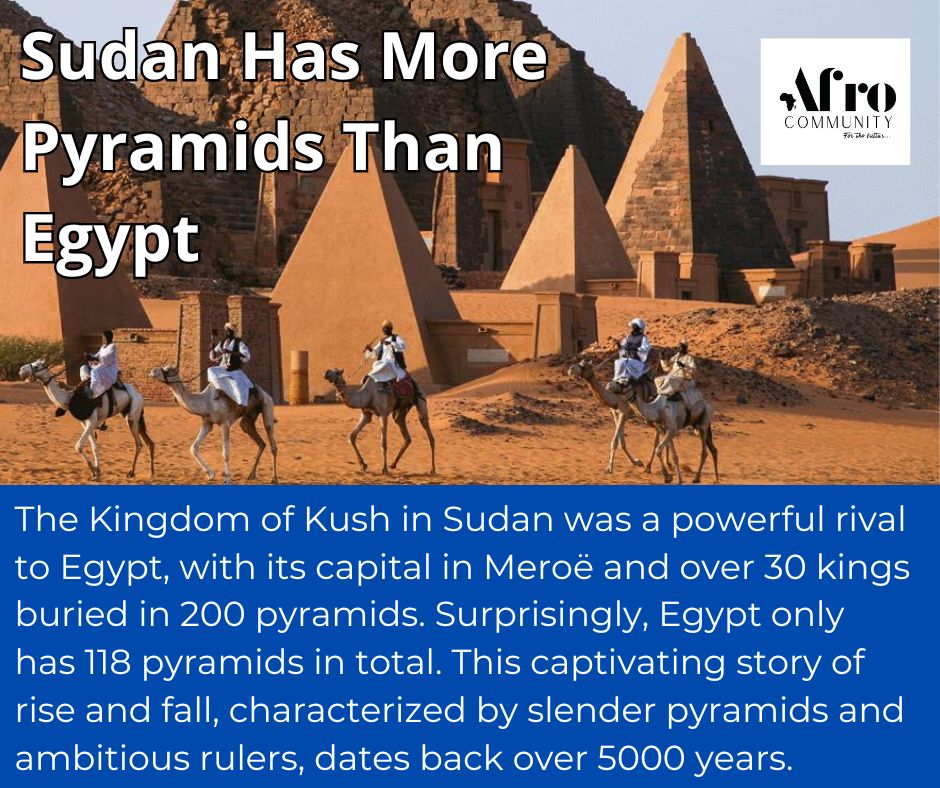The Kingdom of Kush in Sudan was a powerful rival to Egypt, with its capital in Meroë and over 30 kings buried in 200 pyramids. Surprisingly, Egypt only has 118 pyramids in total. This captivating story of rise and fall, characterized by slender pyramids and ambitious rulers, dates back over 5000 years.
Afrocommunity . / Dec. 24, 2023, 6:42 p.m.
During a span of 200 years around 3000 BCE, Egyptian pharaohs ventured south along the Nile River in search of valuable resources like gold, granite, ostrich feathers, and slaves. They established forts and later temples to assert their dominance over the Nubians, who inhabited the central Nile valley, encompassing present-day northern Sudan and southern Egypt. The Nubians are considered one of the earliest cradles of civilization.
As the conquered region became known as the Kingdom of Kush, the Kushites fully embraced Egyptian culture, from their gods to glyphs. They adopted it so completely that when the Egyptian empire collapsed in 1070 BCE, the Nubian dynasty, led by Alara, the King of Kush, spearheaded a revival of Egyptian culture, even constructing their own pyramids.
With the Nubian dynasty prospering both militarily and economically, and believing themselves to be the true successors of the Egyptian God Amun, they launched an invasion of their northern neighbors. Piye, Alara's grandson, led the charge and not only rebuilt the great temples in Egypt but also extended his control over the entire Nile Valley, stretching from Libya to Palestine and all the way down to what is now modern-day Khartoum. Piye became the first pharaoh of Egypt's 25th dynasty, leading to nearly a century of rule by the 'Black Pharaohs'.
Piye, who reigned for 35 years until his death in 715 BCE, chose to be buried in the Egyptian style, a request that his subjects honored. He was entombed in a pyramid, marking the first time in over 500 years that a pharaoh was laid to rest in this manner.
The Meroë pyramids offer more than just archaeological significance. They are built on stunning desert landscapes, far away from any crowds that may spoil the experience | Source: Clare Doolan.
Due to its distance from Cairo, the Kushites were able to maintain their independence and develop their own unique blend of Egyptian culture and religion until the fourth century CE. In their capital, the Meroites constructed temples, palaces, and royal baths, but their most remarkable achievement was the construction of over 200 tall, slim pyramids in the necropolis at Meroë, giving Sudan more pyramids than Egypt (255 in total compared to Egypt's 118). Among these pyramids, the most impressive tombs belong to 30 kings, eight queens, and three princes.
Sudan has a total of 255 pyramids, surpassing Egypt's 118 | Source: Christopher Michel
The complex at Meroë in Sudan, although less renowned than the pyramids at Giza in Egypt, is truly remarkable. These pyramids, which primarily date from 300 BCE to 350 CE, serve as the burial sites for the royalty of the Kingdom of Kush. They are recognized as a
UNESCO World Heritage Site, yet they remain relatively unexplored by tourists. Unlike Egyptian pyramids, Nubian pyramids are smaller in size, ranging from six to 27 meters on each side, compared to the Great Pyramid's 230 meters. They also have much steeper sides. While the ancient Egyptians transitioned to hidden tombs, the Nubians continued to use pyramids, constructing them 2000 years after those in Giza.
Visitors can explore the inside and outside of most pyramids, offering an up-close encounter with ancient hieroglyphics engraved on the walls | Source: Clare Doolan.
By 300 CE, the Kingdom of Kush was in decline. Depleted agriculture and increased attacks from Ethiopia and Rome marked the end of their reign. Christianity and Islam then emerged, causing prayers to the Egyptian God Amun to fade into obscurity.
There have been more than 40 royal individuals laid to rest in pyramids at Meroë. These pyramids were discovered by Frédéric Cailliaud a few years prior, and the news of their existence and the riches they held eventually reached Giuseppe Ferlini, an Italian tomb raider. In 1834, Ferlini arrived at Meroë and began looting the graves, which were still in good condition. He started by demolishing the pyramid of Amanishakheto from the top and discovered a cache of gold and silver jewelry belonging to her. Sadly, Ferlini's actions led to the destruction of over 40 pyramids, much to the dismay of archaeologists.
The Meroë pyramids are situated on a hill and face the East, offering a magnificent view at sunrise as the sun illuminates the ancient architecture. Clare Doolan captured the beauty of this spectacle.
Although the tourism industry in Sudan is not as developed as in Egypt and can be challenging to navigate, there are numerous reasons why adventurous travelers would enjoy a visit. Historical sites like temples, mosques, and necropolises are among the top attractions, while scuba diving in the Red Sea provides incredible experiences. To ensure a smooth journey, it is advisable to seek assistance from a reliable local tour operator.